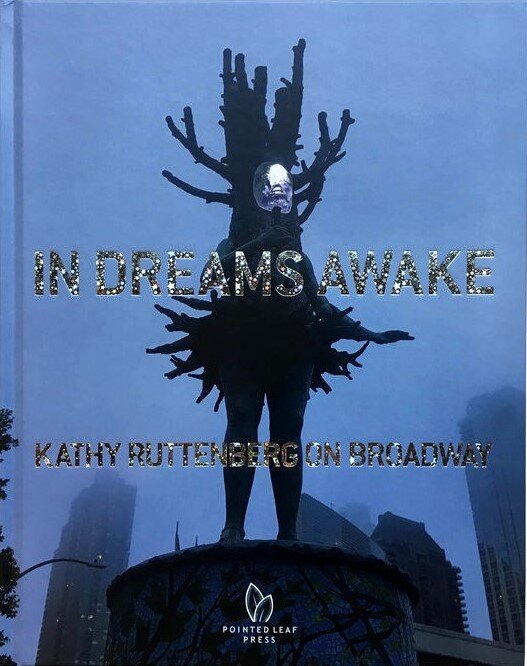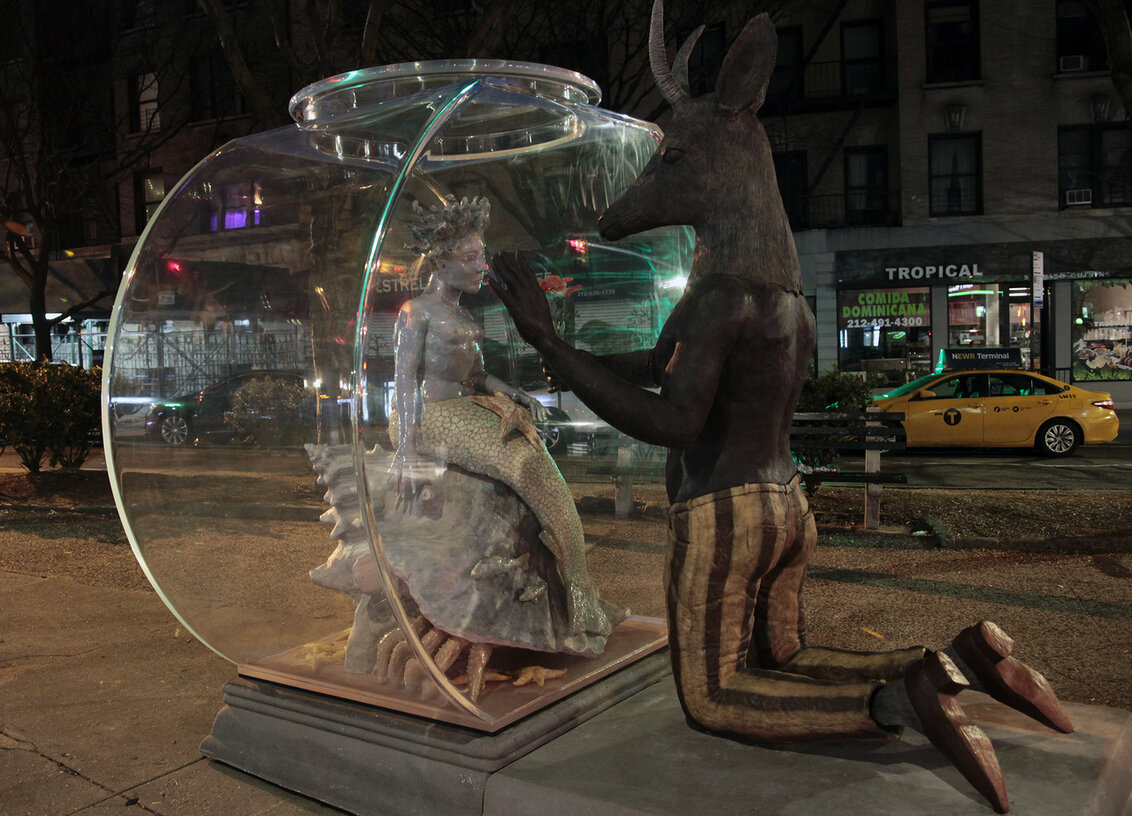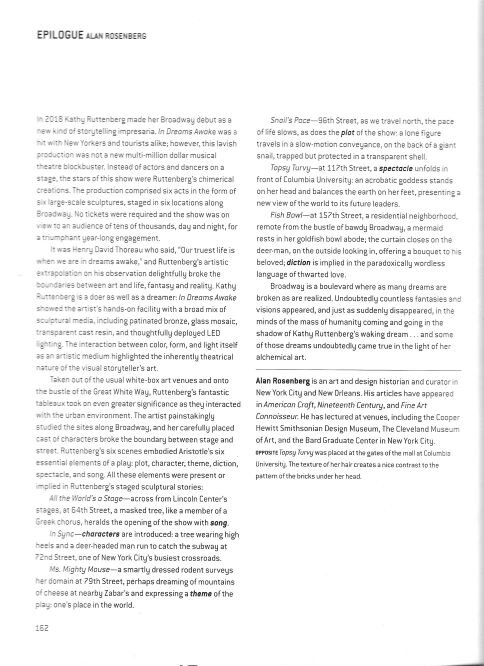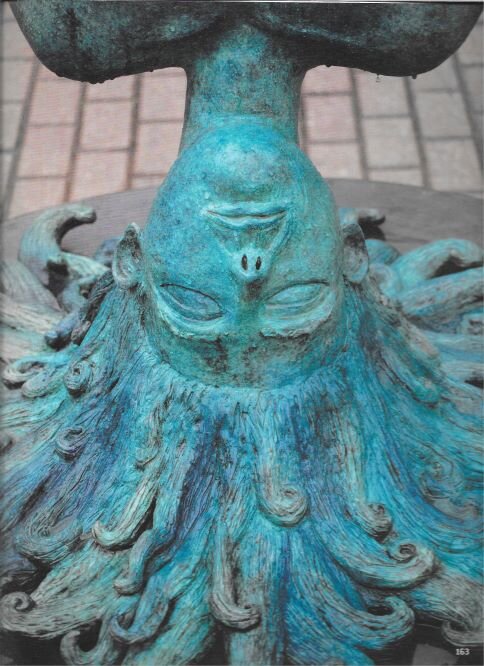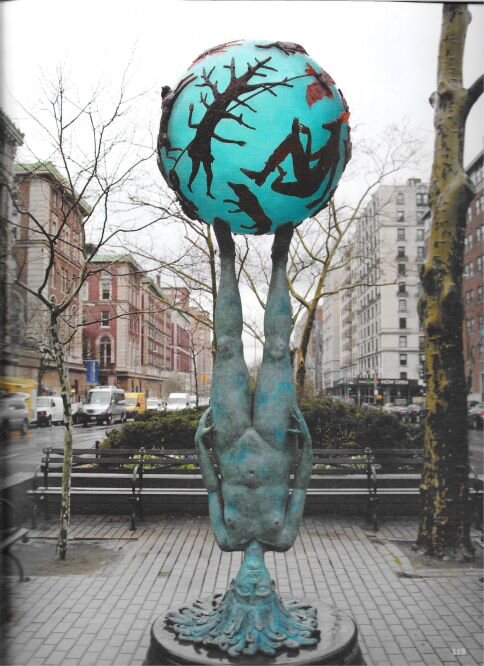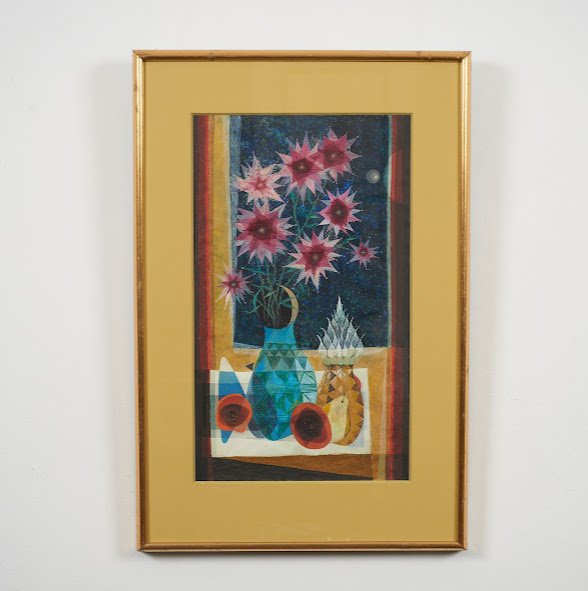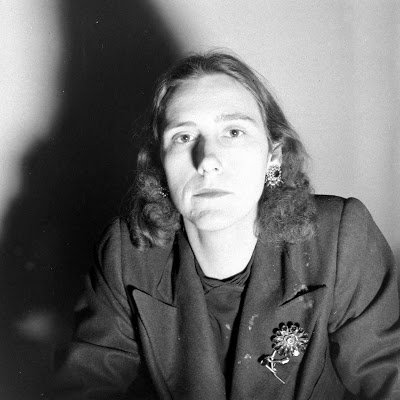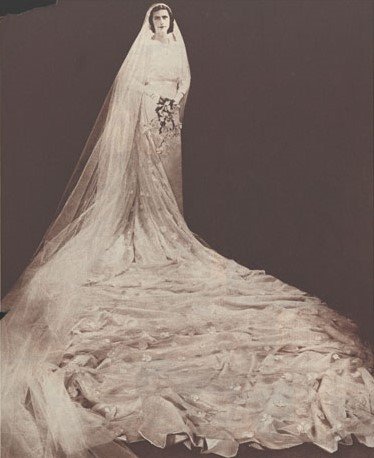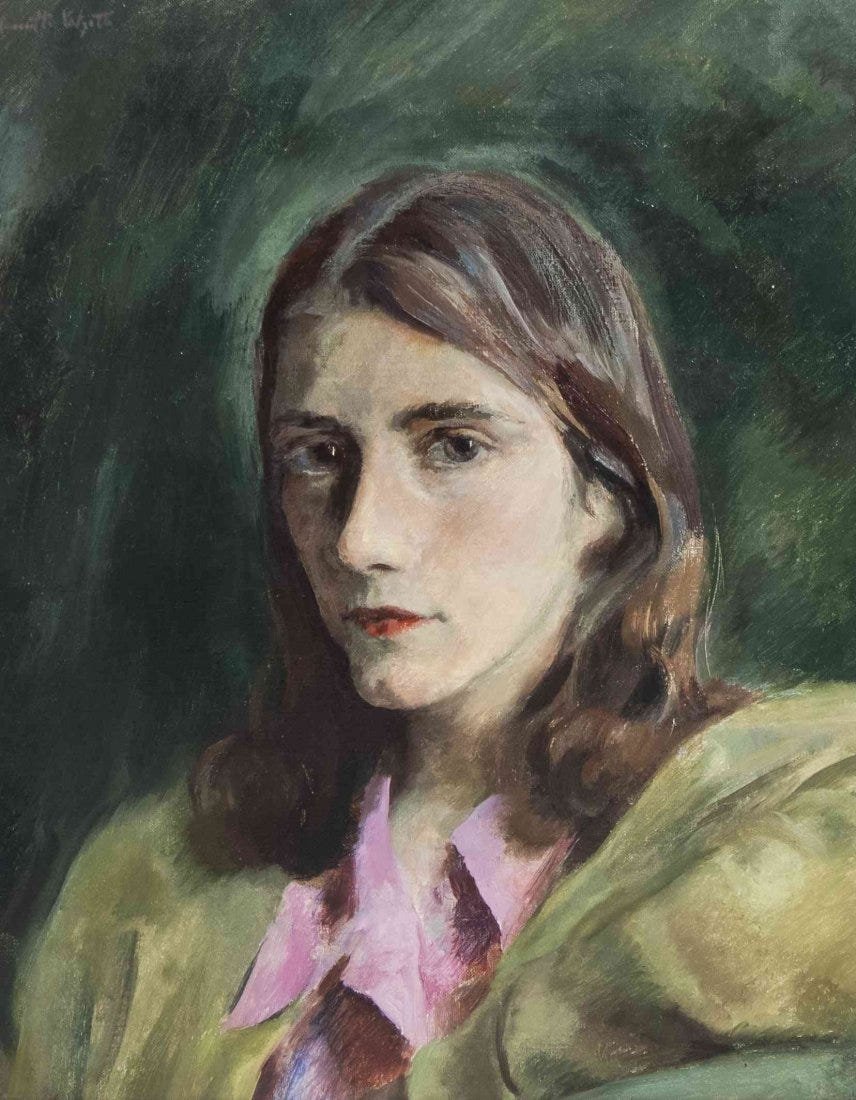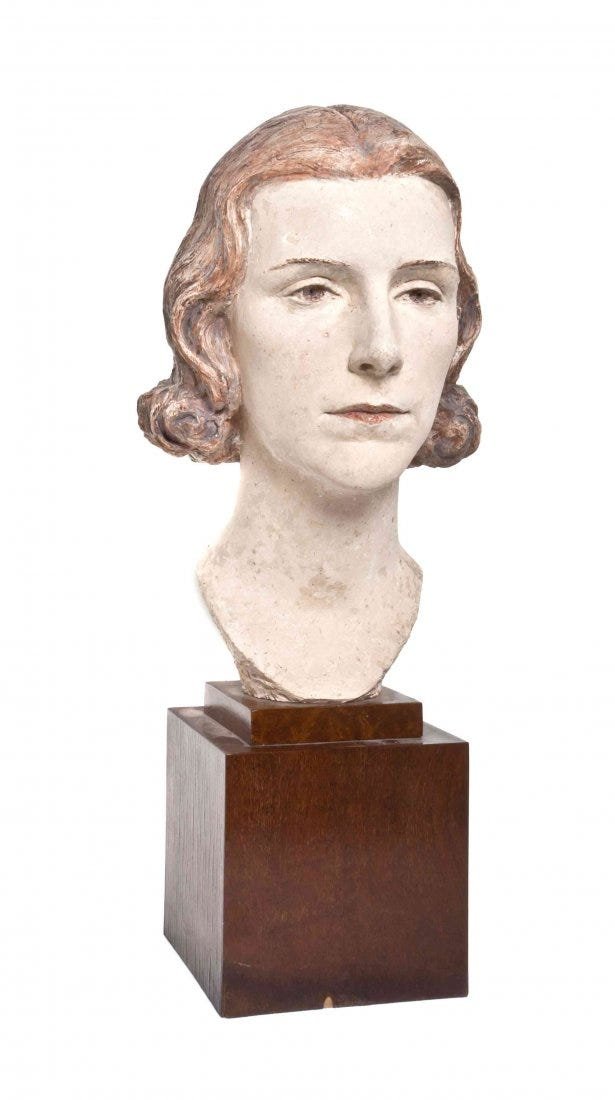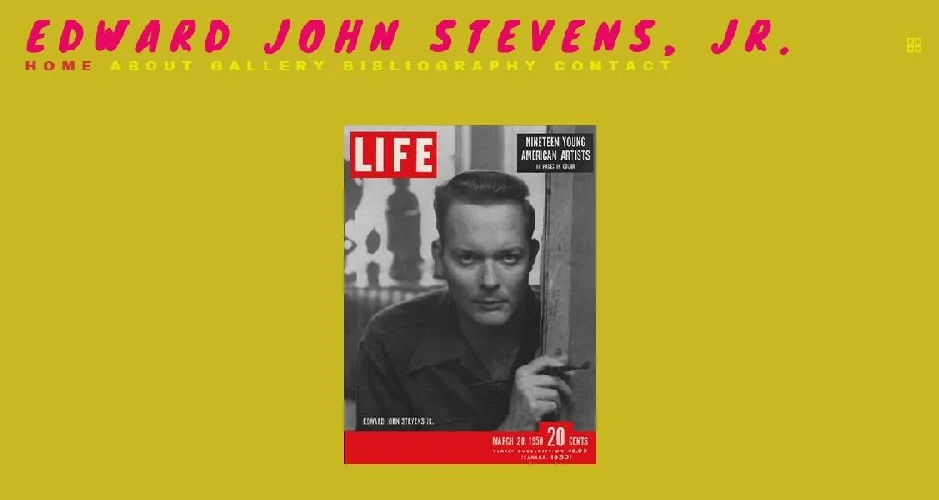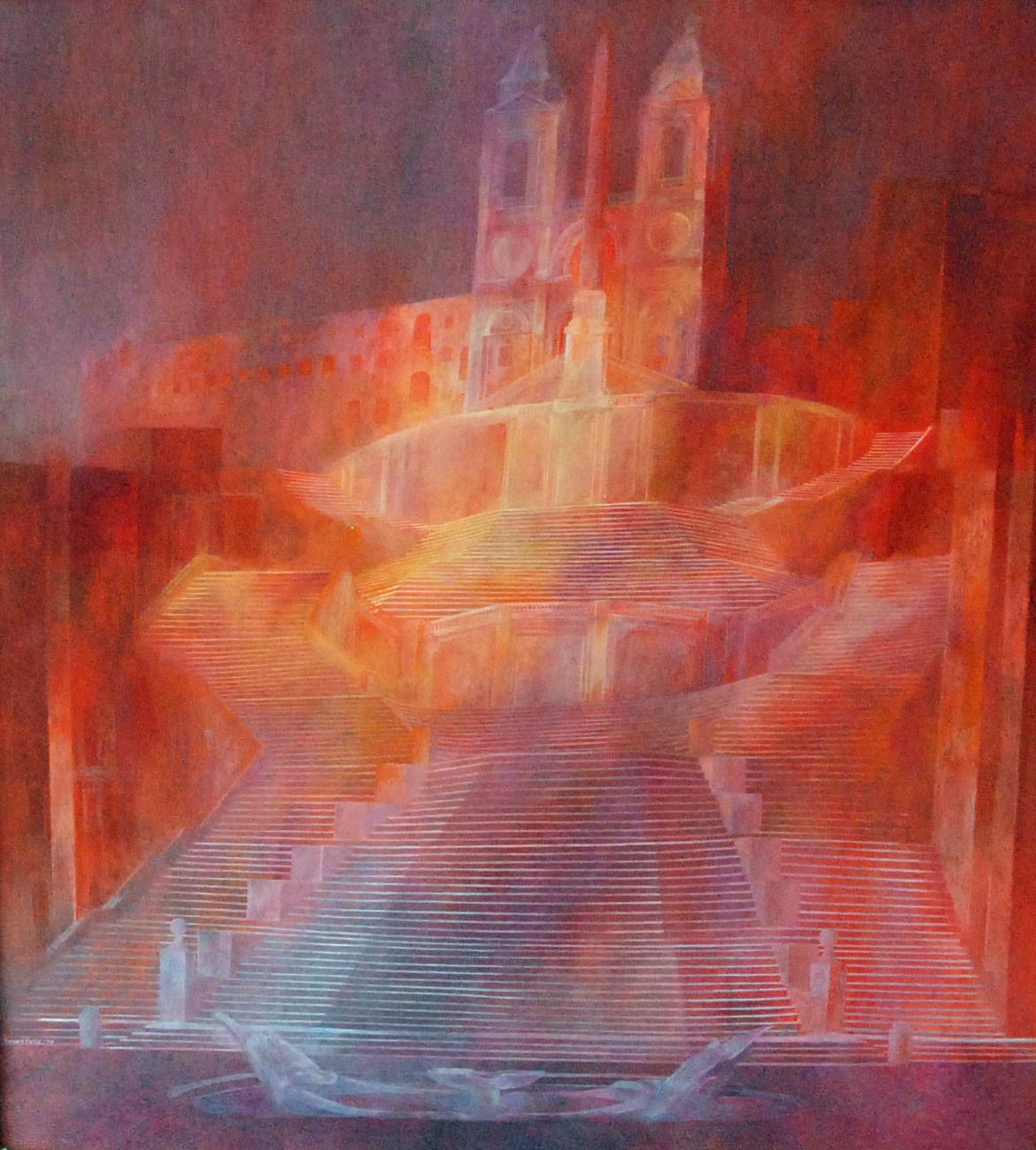I’ve been having fun on Instagram, @alanrosenbergcurator. Do take a look: https://www.instagram.com/alanrosenbergcurator
OBSERVATIONS BY ALAN ROSENBERG
IN DREAMS AWAKE - KATHY RUTTENBERG ON BROADWAY
The exhibition of new sculptures by Kathy Ruttenberg opens today at Francis Naumann Gallery: The vernissage is also a celebration for the newly published book on the artist, for which I wrote an essay. In Dreams Awake: Kathy Ruttenberg on Broadway is pubished by Suzanne Slesin’s Pointed Leaf Press (https://pointedleafpress.com/#/in-dreams-awake/) and includes essays by Adrian Dannat and Deborah A. Goldberg as well as mine (please contact me if you would like to receive a PDF via email). In 2018 Kathy Ruttenberg made her Broadway debut as a new kind of story-telling impresaria. In Dreams Awake was a hit with New Yorkers and tourists alike; however, this lavish production was not a new multi-million dollar musical theatre blockbuster. Instead of actors and dancers on a stage, the stars of this show were Ruttenberg’s chimerical creations. The production comprised six acts in the form of six large-scale sculptures, staged in six locations along Broadway. No tickets were required and the show was on view to an audience of tens of thousands, day and night, for a triumphant year-long engagement. It was Henry David Thoreau who said, “Our truest life is when we are in dreams awake,” and Ruttenberg’s artistic extrapolation on his observation delightfully blurred the lines between art and life . . . fantasy and reality.
In Dreams Awake: Kathy Ruttenberg on Broadway ©2019 Kathy Ruttenberg.
PANURGE - A SONG ABOUT SHEEPLE
PANURGE - A SONG ABOUT SHEEPLE
Music, lyrics and performance ©Dominique Grange, 1968
Translation ©Alan Edward Rosenberg
May 2018 marked the 50th anniversary of "Mai 68" the strikes and riots that led to a total shutdown of French society at the height of the global 1960s revolution. Dominique Grange's song Panurge, released in 1968, with lyrics and music by her, reflects the frustration with modern life that drove many at that time to reject the pervasive manipulations of commercialized pop culture: https://youtu.be/G-ojuCgjkfs.
With supremely Parisian blasé, cigarette in hand, Grange lays out a scene of contemporary life in which the populace is constantly corralled like a flock of sheep and implored to join in the fun (book a discount ski trip!), go on a shopping spree (sale ends soon!!), cheer go team!! (while parked in front of a television), seemingly hypnotized by consumerism and celebrity worship. Grange makes plain that people are like sheep: where one goes the rest willingly follow, even to their own demise. The Panurge of Grange's song is a character in Francois Rabelais' 16th century novel The Life of Gargantua and of Pantagruel. Panurge (described by James Wood in 1901 as "an exceedingly crafty knave, libertine, and coward") buys a flock of sheep but finds he was overcharged. Believing he was cheated in the deal, Panurge, in a fit of miscalculated foolishness, throws one of the sheep into the ocean and the entire flock follows: "Panurge, without another word, threw his sheep, crying and bleating, into the sea. All the other sheep, crying and bleating in the same intonation, started to throw themselves in the sea after it, all in a line. The herd was such that once one jumped, so jumped its companions. It was not possible to stop them, as you know, with sheep, it's natural to always follow the first one, wherever it may go."
Thus Panurge, in French culture, refers to one who misguides the easily misguided, hence the phrase moutons de Panurge, which may best translate into English as sheeple. Grange's contemporary Panurge whips up his flock into a dangerous frenzy leading to an apocalyptic seaside scene in which the singer proposes a neat solution that eliminates the shepherd and his sheep. Grange's French lyrics and my translation are below (corrections welcome). There are a number of expressions with double meanings that will be evident to native French speakers and are difficult to smoothly translate into English: "reviens nous donc" suggests the cries of the sheep to be contained or returned to safety but it also refers to a French expression of desire to return to the topic of conversation ("Je reviens donc à mes moutons" means "let us get back to the subject"); "coups d'klaxons" means honking horns and also refers to the horns of sheep; Grange channels a fashion victim who declares (with some self-satisfaction) that she paid for a couture original "with the eyes of the Devil," ("Elle m'a coûté les yeux du diable") a commodity she must have acquired at great personal risk (like Dorothy and the witch's broomstick). Dominique Grange's song is a triumph of musical, literary and performing talent. Her plaint against the problem of the modern Panurge and her solution are worth revisiting in our current crisis of contemporary culture.
Mais oui vous connaissez son nom
C'est l'inventeur des réunions
Des rassemblements et des groupes
Des trains de neige pour la montagne
Et des week-ends à la campagne
Des encombrements sur les routes
Panurge, panurge
Entends l'appel de tes moutons
Qui te réclament à coups d'klaxons
Panurge, reviens-nous donc
Ça urge!
Je porte une robe formidable
Elle m'a coûté les yeux du diable
Il faut bien payer l'originalité
J'ouvre par hasard le journal
J'y vois ma robe originale
En juste-à-coudre à Bon Marché
Panurge, panurge
Viens visiter tes mini-prix
Où se bousculent tes brebis
Panurge, reviens-nous donc
Ça urge!
Il a suffit que deux garçons
Tapent un jour dans un ballon
Pour gagner au sport un pays tout entier
Mais sur le stade par malheur
J'ai jamais vu que vingt-deux joueurs
Et des millions devant leur télé
Panurge, panurge
Prends donc tes moutons par la main
Entraine-les sur le terrain
Panurge, reviens-nous donc
Ça urge!
Quand tu reviendras, c'est d'accord
En foule on ira sur le port
À la queue-leu-leu sur le quai
Pour contenir tes admiratrices
On aura prévenu la police
Qui te couvrira de bouquets
Panurge, panurge
Ce jour-là fait bien attention
Ils seront là, tous tes moutons
Ils seront déguisés en touristes
En flics, en scouts, en journalistes
Y'aura des moutons photographes
Des agneaux chasseurs d'autographes
Ils seront prêts à t'écraser
À t'étouffer sous leus baisers
Même tu es pris de panique
Pique une tête dans ton public
Puisque tu es le responsable
De tout ça, montre-toi capable
De mourir avec ton troupeau
Panurge, panurge
Pour une fois jette-toi à l'eau
--
But of course, you know his name
He’s the instigator of gatherings
He assembles the crowds
Fills discount ski trips heading to the mountains
Weekends in the country
Traffic jams
Panurge, Panurge
Hear the cry of your sheep
Who honk their horns
Panurge, bring us back
Pronto!
I wear a fabulous gown
I had to pay for it with the eyes of the Devil
You must pay well for originality
By chance I opened my newspaper
There I saw my designer original
In a cut-and-sew kit at Bon Marché!
Panurge, Panurge
Come visit your discount stores
Where your ewes push and shove
Panurge, bring us back
Pronto!
It has been enough for two boys to kick a ball around
To win at sports across the entire country
But at the stadium, lamentably
I never see anything but 22 players
And millions of TV players
Panurge, Panurge
Take your sheep by the hand
Coach them on the field
Panurge, bring us back
Pronto!
When you will return, it is understood
Crowds will gather at the port
In single file on the dock
To contain your female admirers
The police will be on hand
They will cover you with bouquets
Panurge, Panurge
On that day pay close attention
They will be there, all of your sheep
They will be disguised as tourists, as cops, as talent-scouts, as journalists.
There will be the photographer-sheep
The autograph hunting lambs
They will be ready to crush you
To smother you with kisses
Even if you are seized with panic
Dive head-first into your public
Since you are responsible for all this
Show yourself capable of dying with your flock
Panurge, Panurge
For once, throw yourself into the water!
LET'S FACE IT: A GUIDE TO GOOD GROOMING FOR NEGRO GIRLS, 1959
Something from my library for Black History Month, Let’s Face It, Elsie Archer’s “guide to good grooming for negro girls” which was illustrated by Harper Johnson, a prominent African-American artist-illustrator.
"What about fashion fads? Remember the days of the gold hoop earrings? "Earrings as large as bracelets!" . . . our fashion magazines stressed. The fashion picture never looked better than when bracelet loops on fashionable ears were supported by cool crisp cottons with full graceful skirts. But lo and behold, they turned up all over the place--in the classroom, in the office, on crowded buses and subways. More than often in the wrong places. Schoolteacher's blood boiled when girls paraded into classrooms looking like Zulu queens with gold loops larger than arm bracelets. This was one example of carrying a fashion fad a little bit too far. Be very careful when "everybody" does a thing. Know when and where to inject fashion fads into your appearance. Know when these fashion suggestions are good for you. If fashion fads take away from your gracefulness and femininity, avoid wearing them. You must, at all times, be comfortable and at ease in your clothes and in the accessories you wear with them." --Elsie Archer, Lets Face It, illustrated by Harper Johnson, Philadelphia: J. B. Lippincott Company, 1959.
MINTMODA TREND FORECASTING
I have returned to my fashion roots and am blogging for trend forcasting firm MintModa . I am reporting on the historical roots of the latest fashion trends and have recently written about Demna Gvesalia's revival of the Mother Hubbard dress ("One of the latest and most surprising fashion trends has hit 57th and 5th: a window at Bergdorf Goodman features a dress from the house of Balenciaga that many people would otherwise recognize from the 1970s television show “Little House on the Prairie.” Despite its humble origins, the prairie dress--also known originally as the “Mother Hubbard” dress--is the latest in Paris chic, and this is not the first time the modest style has been the new thing in the world’s capitals of fashion"). Another recent post explores the potential influence of the upcoming exhibition of late 19th century symbolist art coming in June 2017 to the Guggenheim Museum ("The Symbolists had strong ideas of women and their appearance. This was the era of the Femme Fatale and the Symbolist woman was as fatale as it gets. Symbolist style was the heroin chic of the fin-de siècle. Some of the themes that obsessed the Symbolist painters show up in what can correctly be called the “alternative” fashions of the turn-of-the-century"). Please check MintModa for the latest blog posts.
EAST VILLAGE EYE 2016
I am excited to let you know that I have edited the fashion page for the new commemorative edition of the East Village Eye that also serves as the catalogue of the East Village Eye exhibition that opens at Howl Happening on Friday, September 16 at 6 PM - 8 PM. The fashion page is a collaboration with street style photographer Anka Itskovich. I wrote articles and styled fashion for the Eye 30 years ago!! My short essay is as follows: Fashion is about change but style has an element of continuity. Fashion can be found in the East Village but East Village style can be found everywhere. Style expresses both individuality and tribal identity. Fashion is a two way street: the East Village is geographic home and destination for designers like Victoria Simes and Katelyn Fay, featured here, but it is also a destination of the mind for globally known designers like Vivienne Westwood (who has collaborated with Keith Haring) and Rei Kawakubo (who finds inspiration in street punk style). Over the decades East Village fashion has meant suede fringe, love beads, vintage Americana, embroidered Ukranian blouses, neon Spandex, motorcycle jackets, peacock-colored hair and combat boots. Today it might mean all of those elements combined in one outfit—and the kids know how to pull it off. The street is your runway so bring it, show it, wear it. It’s a daily responsibility so don’t let us down.
I invite you to follow me on Pinterest where I pin art, objects, interiors . . . the usual Pinterest stuff. I also have some very focused boards such as Mainbocher in the 1960s and Carlyle Brown.
TIGER MORSE BY MARK SHAW: JET-SET STYLE QUEST, 1962
The creativity of two remarkable personalities is on display in an exhibition at Liz O’Brien’s New York gallery this fall. The show is a time capsule of photographs by Mark Shaw of the wildly innovative fashion designer Tiger Morse, known as much among style insiders for dropping out of the fashion business than for contributions to it.
Mark Shaw, whose photographs of Christian Dior couture and of John F. and Jacqueline Kennedy have been rediscovered in recently published books, was a close friend of Morse’s. They ran in the same circle of creative high society and both were clients of Dr. Max Jacobson, the notorious "Dr. Feelgood," known for supplying his celebrity clients (including JFK) with "miracle tissue regenerator" shots, super-charged with liberal doses of amphetamine.
In 1962, the year Shaw captured her on film, Morse was a fashion entrepreneur with a chic boutique, “A La Carte,” which opened in 1955 in an Upper East Side townhouse. Her clients included Jacqueline Kennedy, Jean Harvey Vanderbilt and Mrs. Harcourt Amory, Jr., which led to her designation as “the design pet of the jet set.”
The daughter of a prominent New York architect, Morse grew up in Manhattan and graduated from a posh boarding school. In addition to her background and design talent she had the advantage of her looks: the body of a model and a face of marvelous character. Her exuberant spirit was captured in early black-and-white studio portraits by Mark Shaw, never-before-published and included in the exhibition.
Morse traveled throughout Asia on fabric buying trips, with Shaw accompanying her on assignment from LIFE magazine, documenting her itinerary in brilliant color. In Shaw’s photographs Morse visits a street market in Hong Kong, rides an elephant in Benares, exchanges fashion tips with a Shinto priest in Kyoto and visits waterside weavers’ compounds in Bangkok. Multiple changes of outfits show that Morse was her own best model but Shaw’s fashion portraits of Morse’s clients, including Academy Award-nominated young actress Nancy Olson and socialite Mrs. Alfred Gwynne Vanderbilt, show off Morse’s singular influence.
The exhibition is curated by design historian Alan Rosenberg with the Mark Shaw Photographic Archive. The show runs from November 4th to December 18th 2015 at Liz O’Brien, 306 East 61st Street in Manhattan. For more information visit www.lizobrien.com or call 212-755-3800.
TIGER MORSE
Some of you know that I have been working on a biography of Tiger Morse, the avant-garde fashion designer active in New York in the 1960’s. I am very excited to share with you an article on Tiger Morse that just came out in the March issue of Italian Vogue in which I am quoted. The article, by Maria Grazia Meda, is illustrated with photographs of Morse by Mark Shaw. The article mentions the September 2015 exhibition of Mark Shaw's photographs of American fashion that I am pleased to let you know I am curating for Liz O'Brien gallery here in New York. The Vogue Italia article is shown below--if you would like a pdf please contact me.
WET, THE MAGAZINE OF GOURMET BATHING, 1976-1981
I am pleased to tell you about an exciting exhibition to which I have loaned a rarity from my private library. I was contacted some months ago by Margherita Hohenlohe who had heard that I had a copy of issue number one of Wet: the Magazine of Gourmet Bathing. I do have that hard-to-find issue as well as an almost complete run of the magazine that was published in Los Angeles from 1976 to 1981 and which was among the first of its time to cover esoteric and underground aspects of art, design, music and fashion within a conceptual stream ("gourmet bathing") that floats throughout the magazine. Ms. Hohenlohe has successfully gathered a complete set of Wet that is now on view until 21 September 2014 at Udolpho, her Berlin exhibition space for rare books and manuscripts (my copy of issue number one is not for sale). An exhibition of and about Wet was suggested by artist Julian Göthe and Hohenlohe brought on German cultural critic Diedrich Diederichsen to write a text, excerpted as follows:
When Leonard Koren initially founded WET Magazine for Gourment Bathing and had the term “Gourment Bathing” registered as a trademark, it seemed to be more like an eccentric outburst in the midst of the very particular scene of Venice Beach around 1976. Freak and hippy culture were a thing of the past, but an unbridled Californian hedonism continued to look for outlets and targets. Around 1976, the founding of magazines was not yet part of existing Punk and Fanzine culture. With his background in architecture, Koren’s magazine was initially supposed to pursue a particular interest in the field of interior design: sophisticated bathing. In doing so, it was possible to show playful interiors and interesting naked people, as well as realise crazy graphic design dreams. Furthermore, inspired by all kinds of representational forms, such as collage and contrast, which lie beyond the canon of psychedelic graphics, it was also possible to accumulate a large number of advertisements from the culturally still quite scattered world of the very early dawn of the Californian New Wave.
However, WET was not only a success with advertisers in fashion, gastronomy and architecture: Koren’s team was soon joined by people who would have a much greater influence which would stretch far beyond Californian culture. The graphic designer and cartoonist Gary Panter shaped the appearance of Californian New Wave and Post-Punk counter culture like no other. And this Post-Punk also didn’t happen after Punk; like British Punk or its cousin from Cleveland, Ohio, it happened at the same time. One can also observe this by looking at the history of The Residents, whose independent record releases are advertised at various different places in WET. Gary Panter was not only responsible for creating these ads (and, later on, the covers of other publications that were run by the Residents’ own label Ralph Records), but he also had immense influence on the editorial component of WET. Panter’s mannered, jagged, grotesque layout was absolutely and antagonistically contrary to the older competition of psychedelic graphics, LSD-ornamentation and underground comics—yet shared with it the enthusiasm for complexity, abundance and overkill.
Panter’s rise, however, also needs to be seen in the context of the opening of the magazine to all phenomena of a new underground culture far beyond interior design and avant-garde illustration. Performance art—such as the infamous transgressions of the early John Duncan (sex with corpses), representative of the very first signs of a new post- Cal-arts scene—is the subject of extensive coverage, and the repeatedly portrayed and interviewed Henry Miller acts as a cool father figure. New pop music floods into the magazine from every direction—even if the opposite of a taste-police had its say: Devo, of course sensational in 1978, are positioned right next to old rock, such as the J. Geils Band. The impression which one often has of very early manifestations of what would later become successful scenes, suggests that one is dealing with a closely linked but potentially very diverse provinciality. . .
. . . WET developed out of the applied arts, with its most original contributors coming from the fields of graphic design and illustration. Alongside Gary Panter, this included the young Matt Groening, who is known to the world as the inventor of The Simpsons. Groening, who not only entertained American underground and city magazines with his two comic strips Life in Hell and Akhbar & Jeff for almost a decade, but also worked as a music critic, first began to experiment with his bunny characters at WET. One best appreciates the heterogeneous density of WET by looking at what became of it: on the one hand, The Simpsons and The Residents, and on the other hand, the Japanese horticulture books that Leonard Koren writes today—and lots of other things in-between, whose connections we can only reconstruct if we once again attentively leaf through the 34 issues of WET that were published between 1976 and 1981.
In addition to Diederichsen’s text the gallery has published an exhaustive index to every issue of the magazine, crediting the personnel involved with each issue as well as the listing all the articles. I look forward to working with Margherita Hohenlohe again and to visiting her important venue for the display and study of material that, although originally intended to be ephemeral, now has an indelible place in our culture both underground and mainstream. Exhibition on until 21 September 2014. For more information visit Udolpho.
Issue number one of WET: The Magazine of Gourmet Bathing, May/June 1976
THE SAINT JAMES ENCYCLOPEDIA OF FASHION
I just discovered that the essays that I wrote some years ago for Contemporary Fashion--republished later as the St. James Encyclopedia of Fashion--are available online. The Encyclopedia was edited by the late Richard Martin who was the curator at the Costume Institute, Metropolitan Museum of Art. My entries in the encyclopedia are Adolfo, Carven, Elisabeth de Senneville, Dorothee Bis, George Stavropoulos, Valentino and Vicky Tiel. Many other wonderful authors contributed entries including Valerie Steele, Rebecca Arnold, Madelyn Shaw and Kevin Almond. To browse the entire Encyclopedia visit www.fashionencyclopedia.com
Top row: Adolfo, Carven, Elisabeth de Senneville, Dorothee Bis. Bottom row: Vicky Tiel, Valentino, Adolfo, Vicky Tiel
JAN YOORS IN ARCHITECTURAL DIGEST
The June 2014 issue of Architectural Digest has an article on a subtly stunning home on the island of Nantucket designed by Simon Jacobson of the firm of Hugh Newell Jacobson. Prominently featured in the decor is a large, vibrant tapestry by Jan Yoors, circa 1975. The tapestry is magnificently installed in a place of prominence under a high gabled ceiling that, like the design throughout the house, is strikingly modern in a traditional vocabulary. Works on paper by Yoors fill the walls on either side. In 2000 I curated the first major exhibition in New York of Yoors' abstract tapestries following his death in 1977. The exhibition, at Icon20, included gouache studies and sculptures as well as tapestries from 1970-1977. You can read about the exhibition and see some installation views on my Exhibitions page. The Nantucket home in Architectural Digest is beautifully described by David Colman, photographed by Douglas Friedman and the article was produced by Carlos Mota.
Margery Hulett Brown in Charles James by Cecil Beaton
If you are in New York don't miss Charles James: Beyond Fashion, the current exhibition at the Costume Institute, Metropolitan Museum of Art (on view until 10 August 2014). James was a sculptor in fabric and one of the greatest designers, in any medium, of the 20th century. The clothes are beyond spectacular, although I did not love the exhibition design by Diller Scofidio and Renfro which is pretentious, dark (literally) and competes with the clothes. Charles James' designs are fit for an empress but the exhibition design is the emperor's new clothes. Of course it's a tradition in New York to criticize the installation of exhibitions in the Costume Institute: people have complained that the theatrical exhibitions compete with the clothes on view since Diana Vreeland established the pattern during her tenure as Special Consultant from 1972 to 1989, and her taste and judgement were ultimately unassailable. In any case, it might interest you to know that in the famous Cecil Beaton photograph (used on the cover of the exhibition catalogue) the model looking into the mirror on the right (on the left in the detail on the book cover) is Margery Hulett Brown, the wife of artist Carlyle Brown (some of the other models are Carmen dell'Orefice, Sunny Harnett and Dovima). Carlyle and Margery Brown were members of the social milieu that is so well documented in Thierry Coudert's recently published Cafe Society Carlyle Brown was a protege of Pavel Tchelitchew who Charles James cites as an influence. Among Brown's patrons was the collector/poet Edward James, at whose home West Dean, the Browns stayed at for several months and through whom they may have met Beaton. There are a number of works by Carlyle Brown on my collections page and you can see more photographs of Margery Brown and read my essay on the artist at the site: www.carlylebrown.com
Danny Pierce, artist, dies, age 93
Danny Pierce, artist and master printmaker, died at his home in Kent Washington on March 6th 2014 at age 93, two weeks after the death of his wife. You can read his fascinating obituaries online at the Kent Reporter and the Milwaukee Wisconsin Journal Sentinel. In 1953 Pierce created Fish in Nets 2, a masterpiece of etching and aquatint which I included in my 2011 exhibition at Good Design, Image and Abstraction: American Color Prints of the 1950’s.
J.T. Abernathy celebrates 91st birthday in 2014
This article, which appeared last year in the Ann Arbor News, celebrated the 90th birthday of one of that Michigan town's most noted residents, ceramist J.T. Abernathy. The article is illustrated with an example from my collection. Abernathy studied at the Cranbrook Academy of Art with famed Finnish ceramist Maija Grottel. To read the article visit the Ann Arbor News.
Edward John Stevens, Jr at Beth Urdang
Beth Urdang Gallery in Boston is showing works by Edward John Stevens Jr. until 22 March 2014. Beth Urdang has gathered together a group of vibrant, outstanding works of the 1940s that show Stevens' observations and fantastic interpretations of his travels to Mexico, the South Pacific and other exotic locales. The exhibition received a very positive review in the Boston Globe written by Cate McQuaid. Visit Beth Urdang at http://www.bethurdanggallery.com/exhibitions/stevens/ See more on Stevens at my site devoted to the artist: www.edwardjohnstevens.com
Still Life With Flowers, 1951.
Bernard Perlin, 1918-2014
I regret to report that Bernard Perlin died on Tuesday 14 January 2014. Perlin and his art came to my attention when I was doing research on Edward John Stevens, Jr. Both artists were included in a 1950 Life Magazine article titled Nineteen Young American Artists. After acquiring a work by Perlin I contacted him and visited him at his beautiful home in Ridgefield, Connecticut, where he painted, grew pelargoniums in a glasshouse and enjoyed the company of wild turkeys and any other fauna that walked by his window. I subsequently acquired more work by the artist and eventually wrote an article on him that was published in 2012 in Fine Art Connoisseur magazine. Please contact me if you would like a pdf of the article. I also collaborated with Michael Schrieber in creating a website dedicated to the artist. Bernard Perlin was a beautiful, humble, sophisticated person. His painting "The Jacket" (shown here) is in the collection of the Whitney Museum of American Art.
Provenance Research: Katrina McCormick Barnes
I recently acquired "A Night Still Life," a 1953 gouache by Edward John Stevens, Jr. which was previously owned by Katrina McCormick Barnes. Mrs. Barnes was a rather remarkable person which I think you can gather just from the images of her below. She was a member of the well-known Chicago McCormick family, the daughter of Joseph Medill McCormick and Ruth Hanna. In 1935 she married Courtland D. Barnes, Jr. She lived for many decades in New Mexico and died in Santa Fe in 2011 at age 98. She served on the boards of the Native American Rights Fund, the National Council of LaRaza, the American Civil Liberties Union and the Chicano Education Project, Her memory lives on particularly in the scholarship in her name that she endowed for minority students at the University of Denver.
Edward John Stevens, Jr. website
Dear Friends: I am excited to let you know about the debut of www.edwardjohnstevens.com, a site I have created devoted to the life and work of artist Edward John Stevens, Jr. The "about" section has a rather long essay but if you take a few minutes to read it I think you will find it interesting. Thanks for taking a look, -Alan.
Bernard Perlin Website
I am so pleased to let you know about the debut of www.bernardperlin.com, a site devoted to the life and work of 94 year old artist Bernard Perlin. I wrote all the content and collaborated with Michael Schreiber, who has been working tirelessly to catalogue the artist's work, and Ken Klein who designed the site. My essay on the artist is excerpted from a longer article that appeared in the December 2012 issue of Fine Art Connoisseur (please contact me if you would like a copy of the article). Thanks for taking a look.

